Are you looking for the 7 Best Rangefinders for Deer Hunting? you are at the right spot. No matter if you want to shoot deer with a bow or a rifle, deer hunting has long been a popular leisure activity. Nonetheless, a rangefinder is a crucial tool for shooting deer. You can determine the precise distance between you and your targets using the best rangefinders for deer hunting.
Deer hunting is a difficult activity; you must assess the distance, look for a suitable opportunity, and then act. Thus, quick distance acquisition speed on the rangefinder is one essential for deer hunting. Of course, the measurement of distance should be quite precise.
You’re going to the store to buy the ideal and long-lasting range-finding supplies for the next hunting season. But keep in mind that you have enough knowledge to make a sensible choice for the best hunting rangefinders, regardless of whether you choose a standard archery rangefinder or a multifunctional rangefinder.
7 Best Rangefinders for Deer Hunting-Our favorites
When shopping for the 7 Best Rangefinders for Deer Hunting, you’ll come across a lot of different brands, and if you don’t know what you’re looking for, you can become confused. Sorting through the brands is a laborious process.
We are here to help you as a result of this. We’ve done the research and compiled a list of the 7 Best Rangefinders for Deer Hunting so that you can choose the best rangefinder with ease. I’ll start now.
1) Vortex Optics Ranger 1800
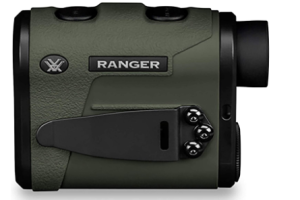
An excellent rangefinder for bow, rifle, or arrow hunters. It provides HCD or slope-corrected angle. The range is provided in straight lines using the line of sight feature, which ignores angles. Because of its resistance to fog and water, smooth rubber grip, and solid frame, it is a rugged and long-lasting instrument.
The most popular rangefinder nowadays is without a doubt the Vortex Ranger 1800. It is a great rangefinder for hunters and has a rubber-based, long-lasting construction. It has a belt clasp and is water-resistant. The best rangefinders for shooting at distances more than 1,000 yards have choices for mounting on a tripod.
The maximum range for glossy or reflective surfaces is 1,800 yards. For dark things like deer, elk, or trees, it extends up to 900 yards. In low light, it has a 700-yard range. Generally speaking, it is the best gear for rifle hunting.
The most notable feature is the warranty, which is lifelong and may be modified or replaced at any time, any place. Due to its 6x magnification, 17 mm eye comfort, compact and strong design, lanyard, tripod installation capability, and waist fastening features, it is the perfect equipment.
Features
- Its 6x enlargement
- Eye comfort of 17 mm
- Robust and compact design
- Tripod installation capabilities, lanyard
- It is the ideal apparatus.
Pros
- Obtainable with essentials
- Easy on the eyes
- Precise correction for angles
- Extended warranty
Cons
- Short range for things in the dark.
2) Leica Rangemaster CRF 2400-R

For angular distance computations for non-reflective objects from 10 to 1000 yards, it has EHR technology. Distances that are not angular and linear can be estimated up to 2400 yards.
The Red Display screen is ideal for shooting at a distance in low light. The waterproof qualities and anti-fogging nitrogen solution improved the construction’s quality and longevity.
It has a wide field of view and can switch between yards and meters. Moreover, the display has automatically adjusted the lighting. While long-range shooting is the aim, the sleek, fashionable black frame offers solidity and fits comfortably in the hand.
Included are a CR2 battery, a connecting wire, and a casing. The requirement for a scanning procedure, which is disregarded if you are not going for a quick item, is the only negative that we could find. It cannot be mounted on a tripod, which is unneeded and the best option for novice hunters.
Features
- Its field of view is expansive.
- Modifying the illumination
- Stylish black frame provides stability.
- EHR technology is present.
- Red computer screen
- Waterproof characteristics and a nitrogen solution that prevents fog
Pros
- Durable
- Quick scanning
- Waterproof
- Automatic luma adjustment
Cons
- Expensive
3) Bushnell Engage 1700
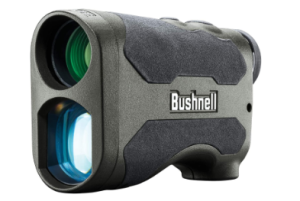
A redesigned and improved display as well as a light adjustment for varying light strength are highlights of this Bushnell rangefinder. The rangefinder works well for shooting deer between 5 and 900 yards, and 1300 yards for bright things.
The brush approach disregards bushes and tree limbs for optimal target accuracy. The ARC, or angle range adjustment, option was helpful for both long-range hunters and tree-position shooters.
This rather quick and inexpensive rangefinder includes a CR2 power and a 6X magnification. Water, dirt, and grime are not able to penetrate the exo barrier layer. The guarantee is perpetual for optics but not for electronics.
After the initial setup is over, utilizing it is fairly easy and intuitive. Even though it is not necessary, tripod installation is not included.
Features
- Magnification of 6X
- For the brilliant objects, 1300 yards.
- Arcs or angles for sloped terrain
- Gives a better resolution
Pros
- Lucid display
- Robust rubber construction
- Angles or arcs for incline terrain
- Provides higher resolution
Cons
- Unacceptable for dark things
4) Simmons Venture Rangefinder
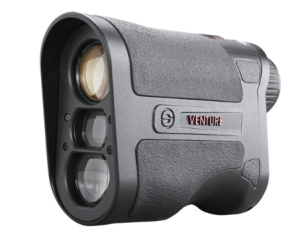
Rangefinders from Simmons are available in Normal and Angle versions. The tilt variation takes the angle into account for tilted images. The range for reflected targets is greater than 400 yards for trees and shrubs. Long shots are challenging to maintain steadily.
Both yards and meters are measured by the rangefinder. Plastic is used in construction since it is durable and long-lasting.
There are two variations based on the change of the angle. First off, if your level differs from the target’s, or if the target’s distance from you is greater than usual, you might need the one with an angle adjustment.
Although it features a hole that can be placed into a thread, a lanyard cannot be attached to it. The structure is somewhat cheap and frail, and it takes a CR2 battery instead of the 9V batteries that earlier models did. Branching makes it difficult to grasp. It functions admirably with a guarantee.
The only drawback we could identify was the requirement for daylight to get an accurate reading. It still hasn’t delivered an outstanding performance at dusk or in low light. Because it has great qualities and doesn’t engage in nightly body hunts, it might be overlooked.
Features
- An opening that can accommodate a thread
- The building is somewhat flimsy and inexpensive.
- CR2 batteries are required.
- Branching makes it challenging to understand.
- It performs brilliantly when backed by a guarantee.
Pros
- Excellent rangefinder
- Lightweight
- Waterproof
- Keep the angle in mind
Cons
- Skinny frame
5) Nikon Prostaff 1000i
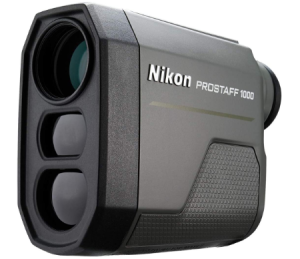
With a single click, Nikon Prostaff can identify things constantly for up to 8 seconds. One of the main complaints of seasoned hunters and golfers is that the aim position does not fixate when the switch is clicked. This function is useful in this situation.
The multi-layer coating of the objective lens provides additional motion. A recent development in weather protection material also makes Nikon Prostaff waterproof. The comfort of the eyes can move 15 mm when wearing glasses. For slopes up to 89 degrees, the Nikon advanced angle computation can calculate the distance. A monocular magnifier with 6x magnification is used.
It comes with a lanyard, a convenient carry box, and a CR2 battery. The Tru-target system’s parameters can be used to calculate the separations between nearer and further objects.
Any item within 500 yards can be hit by precise ranged weapons, even animals that are on the prowl. Bright targets with reflective surfaces are aimed at distances of more than 700 yards. Large creatures can be easily predicted at a distance of 500 yards. For small-scale hunts like those for swooping geese and other birds, it worked out to a range of 300 yards.
Features
- Severally coated lenses
- Containing a lanyard and a comfortable travel bag.
- 6 times the size.
- It calculated to a 300-yard range.
- Accurate long-range weaponry
Pros
- Multiple-coated lenses
- Property of continuous scanning
- Dependable rangefinder
- Including a cozy travel case and lanyard.
- 6x enlargement.
6) Nikon LaserForce Rangefinder Binocular
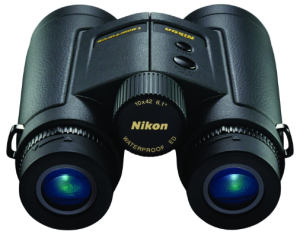
Our best and greatest choice is the Nikon LaserForce Rangefinder Binoculars though expensive The laser Force Rangefinder from Nikon Binoculars comprises a set of binoculars, a scaled-down detection scope, and a rangefinder. The brand-new binocular with a laser rangefinder provides a clear picture. It has a maximum range of 1000 yards for non-reflective targets and 1900 yards for targets that reflect light. The foam eyecups cushion the eyes.
They are provided with objective lens covers attached to keep optics clean at all times. By changing the left and right eye toric lenses, it can easily focus the object according to the user’s eyes.
The 10/42 binoculars have a sturdy rubber exterior, are fog- and water-resistant, and are powered by a single CR-2 battery. The red OLED panel shows accuracy to within 10 yards from 10 to 1900 yards. For long-distance angles, it contains an incline-decline feature that calculates the angle. To conduct an accurate hit at a distance, height must be estimated.
Every laser binocular is a little larger than a regular pair due to the machinery and lenses used. However in terms of overall weight and looks, Nikon Laser Force performs better than its competitors. Light is collected by extra-low dispersion glass by daylight.
Features
- Possess a durable rubber exterior,
- Water- and fog-resistant,
- Powered by a CR-2 battery alone.
- The foam eyecups cushion the eyes.
Pros
- Exceptional range estimation
- Robust design
- Outstanding for long-distance hunting
Cons
- Dark display at the bottom of the screen
7) Vortex Optics Impact 1000
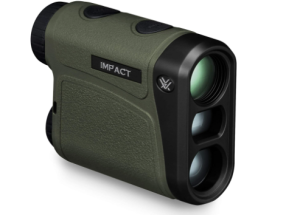
Their entry-level vision, the Vortex Impact 1000, is ideal for shooters from treestands and rifle hunters. The shooting range for elk or deer is 500 yards with built-in ballistics. For complete information, see our evaluation of the Vortex Optics Impact 1000, which we tested and evaluated in a separate post.
The HCD mode offers an angle-corrected range for hunters in steep terrain or archers in tree positions. A flawless line of the site area is provided by the LOS mode.
The minimum allowed is 5 yards. The basaltic range is 800 yards for vegetation and readily extends to 1000 yards for bright objects. The data can be converted to yards or meters at a 6X magnification.
By pushing the button simply once, the scanning feature can scan a wide region or numerous targets. The 15 mm eye comfort is made with hunters who wear eyeglasses in mind. The battery is a common 3-volt CR2 battery.
Features
- Most cost-effective rangefinder
- It can.
- Good eye relief is provided by a 6x magnification.
- Objective lens covered in several layers
Pros
- Best rangefinder for the money
- It has canning capabilities.
- 6x magnification provides good eye relief.
- Objective lens with several coatings
Read Also:
7 Best Rangefinders for Crossbow Hunting
7 Best Rangefinders for Long-Range Shooting
How to Choose the 7 Best Rangefinders for Deer Hunting
Distance
Your ability to quickly locate targets will be aided by higher land, which has the hunter’s scan zone with bright sun, observable ridge portions, and clear tree limbs. Typically, pastures are where animals rest or eat. Look for areas that are lush and grassy.
Another piece of advice for using a rangefinder to find deer or elk is to enter the mountain peaks and ridges. Choose a fort with a view of a hill rising above the forest and facing more blind spots.
Battery
If you only sometimes practice aiming at a distance, this is usually less of a problem, but if you’re a bowhunter, you need to think about battery life. Nothing is more unpleasant than discovering your rangefinder is empty while you are in the middle of a hunt.
This problem could get worse if there is bad weather. Do your research before considering adding battery packs to your collection.
Water-Resistance
The least amount of moisture in the glass can lead to focus problems and even fungus growth, thus ruining your optics. Devices used in optics are sensitive and complex. By employing solid, robust, high-quality cases, you may avoid a lot of issues.
Optics
Material and surface coating of your bow rangefinder’s optics are also very important factors to consider. The greatest rangefinders are fully multi, which implies that numerous protective layer coatings are present on every air-to-glass contact. Yet at a cost, the brightness and resolution usually tend to rise.
Comfort for the Eyes
It is useless to spend money on premium hunting optics and high-quality glass if the range finder’s performance is hindered by inadequate eye relief. Eye relief is the distance your eye must be from the optics to see what you are looking at.
The 7 Best Rangefinders for Deer Hunting FAQs
- What is the range of a range finder?
While hunting rangefinders can detect distances of more than 1300 yards, golf rangefinders typically have a target range of roughly 600 yards. Typically, to-the-pin readings on golf courses don’t surpass 250 or 350 yards.
- How long does a range finder’s battery last?
The battery should last for 40 to 50 rounds of golf, or an average golf season, depending on usage.
- What is the rangefinder’s maximum effective range?
7x25mm optics, 7.7oz weight, the maximum range of 3400 yards, deer at 1200 yards. Fnova: “Easy to use and has a speed measurement capability. Weight: 8.3 oz, maximum range: 1000 yards, 7x. 22mm optics.
Conclusion
After finishing this article, you’ll know more about the rangefinder you’ll need for your upcoming hunting trips. There are numerous choices, but we’ve narrowed it down to the 7 Best Rangefinders for Deer Hunting.
If you’re a long-range hunter or simply looking for a terrific high-end rangefinder you can afford, go no further than the options listed above. You can use any of the hunting rangefinders in our collection both throughout your hunting season and afterward. We would never purposefully misdirect our audience.

